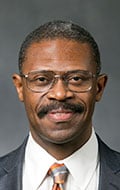You have /5 articles left.
Sign up for a free account or log in.
Social science suggests that stigmatized groups compete for social standing. And a new book that’s part qualitative study, part autobiography, suggests that that trend is evident in higher education among black academics.
“The drawing of ethnic boundaries around a group and the naming of its shared ‘culture’ regularly occurs against the backdrop of a pervasive suspicion or accusation of the group’s inferiority and answers this suspicion or accusation with an exaggeration of the group’s differences from some more validly stigmatized groups,” reads Stigma and Culture: Last-Place Anxiety in Black America (University of Chicago Press). “Ethnic self-fashioning also tends to exaggerate the speaker’s group’s similarities to an ethnically unmarked dominant group.”
 J. Lorand Matory (right), the book’s author, is the Lawrence Richardson Professor of Cultural Anthropology at Duke University and director of Duke’s Sacred Arts of the Black Atlantic Project. He calls this “competitive and hierarchical dimension” of self-identification “‘ethnological schadenfreude’ because its partisans take comfort and bolster their own self-esteem by assuring themselves of the deeper inferiority of some other racial group.”
J. Lorand Matory (right), the book’s author, is the Lawrence Richardson Professor of Cultural Anthropology at Duke University and director of Duke’s Sacred Arts of the Black Atlantic Project. He calls this “competitive and hierarchical dimension” of self-identification “‘ethnological schadenfreude’ because its partisans take comfort and bolster their own self-esteem by assuring themselves of the deeper inferiority of some other racial group.”
Matory employs ethnographic methods, such as conversations with Howard University alumni and students, and draws on social science research, especially Erving Goffman’s work on social stigma. He also interweaves his own personal history attending and teaching at elite institutions, including Harvard University and Duke, arguing that black people in the U.S. often differentiate among themselves based on their cultural backgrounds. The goal? To avoid being associated with negative stereotypes of African-Americans, who historically have been the most stigmatized group in the U.S.
“Any group that can prove it's not black is guaranteed equal rights” in the U.S., Matory said in an interview. “The fourth quintile is desperate to prove to the third quintile that it’s better than the fifth.”
Such “covering,” through dress, diction and other means, happens in academe in subtle ways for similar reasons, Matory says. He tells the story of a black Harvard professor from Mississippi who was chided for retaining a British accent decades after he returned from the University of Oxford, for example.
Blacks of Caribbean or African immigrant origin tend to highlight how their backgrounds differ from those of African-Americans, Matory adds, and sometimes reject the term “African-American” as a descriptor. And blacks of Gullah/Geechee origin (in the Lowcountry Creole areas of Georgia and South Carolina), Louisiana Creoles and Native Americans of partly African ancestry may be quick to reinforce their particular heritage, too, Matory says.
Matory described Stigma and Culture as an historical and auto-ethnography. The book doesn’t focus exclusively on academics, and takes such interesting turns as a tour through the Howard alumni network of New Orleans Creoles, reflections on Matory’s trip to Nigeria as a young man, and the frightening experience of having his young son mistaken for an intruder by neighbors shortly after the shooting death of Trayvon Martin. But the book suggests that self-stratification may be particularly acute among black academics because universities -- especially elite ones -- bring out people’s insecurities.
The majority of students and even faculty members suffer from “impostor syndrome,” Matory said, and are looking for ways to differentiate themselves from those traditionally in “last place.” Universities are also based on largely white European ideals.
Universities play “an ambivalent role in this ethnogenesis,” reads Stigma and Culture. “They defend the discreditable group but establish its legitimacy in the terms dictated by the ethnoracially unmarked dominant group, which also provide an opportunity for the assimilated native spokesperson to establish his or her superiority to his or her co-ethnic fellows.”
Matory said he was inspired to write the book because he grew up in Washington, the son of Howard-educated parents (one of whom was a professor of medicine there) during the civil rights movement. While he always was aware of the cultural differences between himself and some of the other black kids in the neighborhood whose parents were from different countries, he said, they all tended to unite around their shared historical marginalization.
Then, in the 1990s, national conversations about achievement began to focus on the myth of model immigrant, tenuously suggesting that African and Caribbean immigrant children had better educational and life outcomes because they were somehow culturally superior to African-Americans. Matory began to investigate this myth though various means, leading him to his theory of ethnological schadenfreude.
He first presented his work in lectures, the most notable of which was the Lewis Henry Morgan Lecture at the University of Rochester in 2008. Stigma and Culture builds on those comments, mixing academic arguments with an intimate look into someone’s lifelong endeavor to understand how ethnicity shapes the world and his own life.
Matory said sometimes people criticize him for talking in such frank terms about race and ethnicity. But for him, he said, the most “dignified” way to talk about his lifelong subjects -- blacks on both sides of the Atlantic -- is to show they’re human beings with flaws.
So does Stigma and Culture have any implications for the current dialogues on race on campus, in which black academics are sometimes treated as a homogeneous group? Matory said he wrote the book as an anthropologist describing a certain phenomenon, not with an eye toward policy. But he said higher education absolutely needs more black faculty members, and by being “consciously aware of the class dynamics and ethnicity dynamics on feeder populations, and how they’re reinforced on university campuses, we can make more thoughtful decisions about how to cultivate diversity.”





